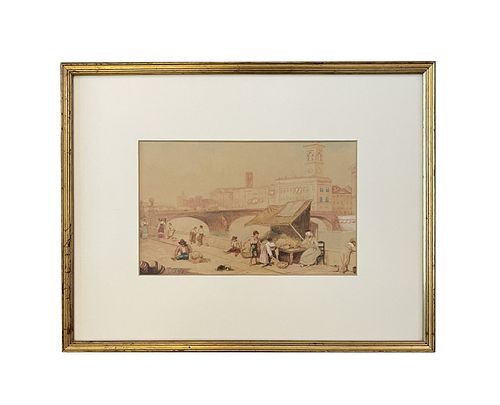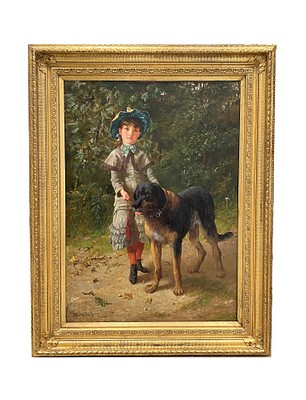Ippolito Caffi (1809 - 1866) Italy
Lot 27
About Seller
Coral Gables Auction LLC
2377 Coral Way
Coral Gables, FL 33145
United States
We are an auction house with a lot of knowledge of our work environment. We recited at Miami FL. We have professionals with more than 30 years of experience. We work hard to provide our subscribers with the best descriptions of the auctioned pieces and their provenance, in addition to providing good...Read more
Estimate:
$2,000 - $500
Absentee vs Live bid
Two ways to bid:
- Leave a max absentee bid and the platform will bid on your behalf up to your maximum bid during the live auction.
- Bid live during the auction and your bids will be submitted real-time to the auctioneer.
Bid Increments
| Price | Bid Increment |
|---|---|
| $0 | $25 |
| $500 | $50 |
| $1,000 | $100 |
| $3,000 | $250 |
| $10,000 | $500 |
| $20,000 | $1,000 |
| $50,000 | $2,500 |
| $100,000 | $5,000 |
| $200,000 | $10,000 |
| $500,000 | $25,000 |
About Auction
By Coral Gables Auction LLC
Dec 7, 2022
Set Reminder
2022-12-07 17:00:00
2022-12-07 17:00:00
America/New_York
Bidsquare
Bidsquare : No Reserve Fine & Decorative Arts Auction #41
https://www.bidsquare.com/auctions/coral-gables-auction-llc/no-reserve-fine-decorative-arts-auction-41-11462
This is the second liquidation auction of the year. The pieces have no reserve. Coral Gables Auction LLC coralgablesauction@yahoo.com
This is the second liquidation auction of the year. The pieces have no reserve. Coral Gables Auction LLC coralgablesauction@yahoo.com
- Lot Description
Ippolito Caffi (1809 - 1866) Italy
Watercolor on Paper
Measure 6"in H x 9 1/2"in W and 12 3/4"in H x 16 1/4"in W with frame
Known for: Architecture, landscape and marine painting-atmospherics
Biography: Ippolito Caffi was an Italian painter of architectural subjects and seascapes or urban "vedute". He was born at Belluno, Italy to James and Mary Castellani. He studied in Belluno and then in Padua with his cousin the painter Pietro Paoletti, who worked in conjunction with another artist from Belluno in neoclassical style. He studied and produced his first work at the Accademia in Venice where he was able to know the Venetian painters of the eighteenth century. His Rialto Bridge is an example of this period. In 1832, Caffi moved to Rome, and in early 1833, opened his own studio, devoting himself to painting and drawing from life. He made some reputation by his treatise on perspective, as well as by his investigations on Roman archaeology. Domiciled in Rome, he often moved to other cities to exhibit his works. In Rome he made a trip in a hot air balloon, which influenced him to paint two pictures almost romantic and also from a unique perspective. In 1843, he visited Athens, Turkey, Palestine and Egypt, returning in 1844 with many sketches and paintings. Caffi was highly political and in Venice in 1848 joined revolutionary movements for independence. This activity led to his being captured in 1848 and detained during that year. In 1849, he lived in Genoa and Switzerland; in 1850 in Turin; and then in London during a series of trips. In 1858, he was back in Venice and in more trouble for political activities as he was convicted in 1860 of "the crime of public violence" and imprisoned for three months at San Severo. After his release, he went to Naples, joined the successful army of independence of Garibaldi, and then returned to Venice to resume painting. Of Ippolito Caffi, it was written that throughout his life he managed to keep a high enough standard of living by selling his paintings, some replicated many times, to European nobility, including the Prince of Austria. Although inspired by models of eighteenth-century Venice, he was able to modernize the vocabulary of pictorial views, by exploring new points of view as in night scenes and with unusual topics such as the flight of the balloon. Although he was much appreciated in life, Caffi had to wait for the mid-1960s to be seriously considered by art historians. With the major exhibition in Venice to celebrate the centenary of his death, appreciation of his painting began to grow. His paintings were very numerous and some of it was lost.Important Message Regarding Payments : All invoices that exceed the amount of $ 2000 including the buyer premium, must make the payment through check or wire transfer, if we receive the payment through the platform, the money will be reimbursed automatically to your cardCondition
Coral Gables Auction strongly encourages in-person inspection of items by the bidder
Statements by Coral Gables Auction regarding the condition of objects are for guidance only And should Not be relied upon as statements of fact, and do Not constitute a representation, warranty, Or assumption of liability by Coral Gables Auction
All lots offered are sold "As Is"
For condition report please contact our auction house via email info.coralgablesauction@yahoo.com - Shipping Info
-
For Shipping Information Please send Email to info.coralgablesauction@yahoo.com
-
- Payment & Auction Policies
-
Available payment options
-
-
- Buyer's Premium



 EUR
EUR CAD
CAD AUD
AUD GBP
GBP MXN
MXN HKD
HKD CNY
CNY MYR
MYR SEK
SEK SGD
SGD CHF
CHF THB
THB













